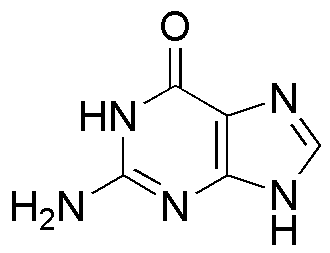Guanine is widely utilized in research focused on:
- Genetic Research: As a key component of DNA and RNA, guanine plays a crucial role in genetic studies, helping researchers understand genetic coding and mutations.
- Pharmaceutical Development: Guanine derivatives are explored in drug formulation, particularly in antiviral and anticancer therapies, enhancing treatment efficacy.
- Biotechnology: In the field of synthetic biology, guanine is used in the design of nucleic acid-based sensors and biosensors, enabling rapid detection of pathogens.
- Food Industry: Guanine is utilized as a food additive for flavor enhancement, providing a natural alternative to synthetic flavoring agents.
- Cosmetics: Due to its antioxidant properties, guanine is incorporated into skincare products, offering benefits such as skin protection and anti-aging effects.
General Information
Properties
Safety and Regulations
Applications
Guanine is widely utilized in research focused on:
- Genetic Research: As a key component of DNA and RNA, guanine plays a crucial role in genetic studies, helping researchers understand genetic coding and mutations.
- Pharmaceutical Development: Guanine derivatives are explored in drug formulation, particularly in antiviral and anticancer therapies, enhancing treatment efficacy.
- Biotechnology: In the field of synthetic biology, guanine is used in the design of nucleic acid-based sensors and biosensors, enabling rapid detection of pathogens.
- Food Industry: Guanine is utilized as a food additive for flavor enhancement, providing a natural alternative to synthetic flavoring agents.
- Cosmetics: Due to its antioxidant properties, guanine is incorporated into skincare products, offering benefits such as skin protection and anti-aging effects.
Documents
Safety Data Sheets (SDS)
The SDS provides comprehensive safety information on handling, storage, and disposal of the product.
Product Specification (PS)
The PS provides a comprehensive breakdown of the product’s properties, including chemical composition, physical state, purity, and storage requirements. It also details acceptable quality ranges and the product's intended applications.
Certificates of Analysis (COA)
Search for Certificates of Analysis (COA) by entering the products Lot Number. Lot and Batch Numbers can be found on a product’s label following the words ‘Lot’ or ‘Batch’.
*Catalog Number
*Lot Number
Certificates Of Origin (COO)
This COO confirms the country where the product was manufactured, and also details the materials and components used in it and whether it is derived from natural, synthetic, or other specific sources. This certificate may be required for customs, trade, and regulatory compliance.
*Catalog Number
*Lot Number
Safety Data Sheets (SDS)
The SDS provides comprehensive safety information on handling, storage, and disposal of the product.
DownloadProduct Specification (PS)
The PS provides a comprehensive breakdown of the product’s properties, including chemical composition, physical state, purity, and storage requirements. It also details acceptable quality ranges and the product's intended applications.
DownloadCertificates of Analysis (COA)
Search for Certificates of Analysis (COA) by entering the products Lot Number. Lot and Batch Numbers can be found on a product’s label following the words ‘Lot’ or ‘Batch’.
*Catalog Number
*Lot Number
Certificates Of Origin (COO)
This COO confirms the country where the product was manufactured, and also details the materials and components used in it and whether it is derived from natural, synthetic, or other specific sources. This certificate may be required for customs, trade, and regulatory compliance.


